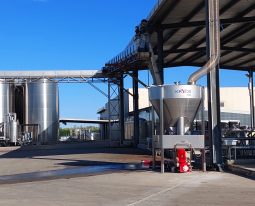
Deossigenazione totale della cotta con risultati replicabili e coerenti ottenuti attraverso un processo completamente automatizzato.
At the “La Guardiense” winery in Guardia Sanframondi, in the province of Benevento, the use of Kryos represents an interesting case study because it confirms the advantages of using this innovative machine in oenology. Hence the decision to incorporate the technology developed by SIAD into the winery’s processing protocols. Kryos is a system suitable for cooling and deoxygenating, or just deoxygenating, pigiad-stemmed grapes using liquid CO2 as the refrigerant.
The experimentation at “La Guardiense” winery was initiated with the aim of responding to some specific requests. Namely: • Identify a physical methodology to rapidly remove dissolved oxygen in the crush • Operate consistently with supply chain structures without interfering with the timing of other processing • Achieve ease of use and standardization of operations
From the processing of winery requirements, CO2 was identified as the deoxygenating fluid. The experimentation was carried out on Falanghina grapes by operating in different ways: • Distribution of carbonic snow in the grape receiving tank • Using Kryos immediately downstream of de-stemming crushing. – With gaseous CO2 – With liquid CO2 The amount of dissolved oxygen in the crush, during testing, was measured downstream of a tube-to-tube exchanger before entering the press. Measurements made without the use of CO2 indicated a dissolved oxygen content between 5 and 7 parts per million.
This purely manual methodology involves the distribution of snow on the grapes as they are discharged into the tank. Snow, during the test, was produced in the basement by a snow-maker using liquid CO2, taken from a special tank.
Applying this technique, operating continuously and fully automatically, the operator’s only task was to press the button to start the system. The crushed grapes, moved by the crusher pump, entered the Kryos where it came in contact with the flow of gaseous CO2 that passed through it stripping the dissolved oxygen. The crushed grapes thus treated were transferred, by pump, to the press.
The third methodology adopted is similar to the previous one, with the variation that Kryos was employed in its chiller function using liquid CO2. In this case, deoxygenation also involves mild refrigeration of the crush. In this specific case, dedicated software managed the supply of CO2 in such quantities that the temperature difference between inlet and outlet was continuously adjusted. Various tests were carried out with temperature differences of up to 4°C. Following the application of the three different methodologies, it was possible to verify that: • Operating with carbonic snow in the receiving tank, the residual dissolved oxygen was variable, with values in the range of 3.5 -7.0 parts per million • With Kryos operating with gaseous CO2, the reduction was greater than in the previous case, but still not constant with the residual in the range 0.1-1.0 parts per million • With Kryos and liquid CO2, by lowering the temperature even by only 1-2°C, oxygen removal was virtually complete and constant during all tests. CO2 used was less than 2 kilograms per quintal treated
At the conclusion of the operations, it was possible to arrive at some considerations. The results showed that: • In the cases of hopper snow and Kryos with gaseous CO2, the poor and inconsistent deoxygenation is attributable to the reduced and uneven mixing between the deoxygenating and crushed fluid consequent to the characteristics of the operating modes • In the case of Kryos with liquid CO2, the excellent results are the consequence of complete and homogeneous mixing between them. This is due both to the thermodynamic characteristics of CO2 in the liquid phase and to the mode of dispensing, which causes it to transform instantaneously into 2 phases upon contact with the crushed mass: solid, snow, which by consequent heat exchange becomes gas, and gaseous. Stages that generate mixing capable of making sufficient gas-pressure contact to remove dissolved oxygen. This mode of work is the only one that fully met expectations; the treated crushed grapes were subsequently processed leaving the protocol normally in use unchanged, with the exception of the part concerning sulfur.
The use of Kryos using liquid CO2, allowing dissolved oxygen to be removed, allowed a very delicate and complex product to be vinified to be handled as a semi-aromatic white without problems. The substantial advantage came from the excellent standardization that the system allows. The absence of oxygen allows the total reduction of sulfur dioxide as far as oxidative aspects are concerned. Starting with the 2020 harvest, the use of Kryos is included in the winery’s processing protocols.
About us
SIAD Group, a century of history in gas production
Among Italy’s leading chemical groups, SIAD is a leader in the production and commercialization of the full range of industrial, specialty, and medicinal gases and related services. The business extends to sectors in synergy with that of gases, including Wine, Food and Beverage.